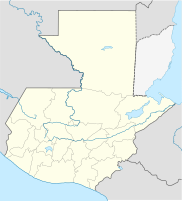Villa Nueva (Guatemala)
| Villa Nueva | ||
|---|---|---|
|
Coordinates: 14 ° 33 ′ N , 90 ° 35 ′ W Villa Nueva on the map of Guatemala
|
||
| Basic data | ||
| Country | Guatemala | |
| Department | Guatemala | |
| City foundation | 1763 | |
| Residents | 355.901 (2002) | |
| City insignia | ||
| Detailed data | ||
| surface | 114 km 2 | |
| Population density | 3,122 inhabitants / km 2 | |
| height | 1330 m | |
| Website | ||
| Bárcena district | ||
Villa Nueva is a city in Guatemala . It is the administrative seat of the large municipality of the same name in the Department of Guatemala . Villa Nueva is part of the agglomeration of Guatemala City .
geography
The municipality is with 114 km² and more than half a million inhabitants together with Mixco the second largest of the 17 municipalities of the department. It is located in the southern highlands of the Sierra Madre , on the southwestern edge of the high valley Valle de La Ermita (also Valle de La Virgen or Valle de las Vacas ) , which is criss-crossed by several gorges, at an altitude of about 1330 meters. In the north it borders on Mixco and Guatemala City, in the east on Petapa , in the south on the somewhat lower-lying Amatitlán and in the west on three municipalities of the Sacatepéquez department . Behind the volcanic chain in the southwest the Pacific lowlands begin. Villa Nueva has extremely fertile soils, the agricultural use of which has gradually had to give way in favor of urban and industrial development. The climate is moderate, the temperatures are usually between 12 and 28 ° C, the rainy season lasts from May to October.
The town of Villa Nueva is located 15 km southwest of the center of Guatemala City in the Valle de las Mesas on the CA 9 motorway to Puerto San José . The urban area has merged with that of Guatemala City in the northeast and is thus part of a closed metropolitan area.
population
According to Guatemalan law, a villa means a community with additional privileges, no longer a village, but also not yet a city. Villa Nueva has not received city rights to this day, although it officially had 355,901 inhabitants in 2002. In the public perception, Villa Nueva is one of the dormitories of the capital (according to the official website: municipio dormitorio ) and is often seen as an integral part of it, although both are administratively independent. Villa Nueva is one of the fastest growing communities in Guatemala and is estimated by some to have a population of close to one million. This also includes numerous weekend commuters who stay with relatives or friends on working days, and people who are officially registered in other departments or not at all but still live in Villa Nueva.
history
Villa Nueva (Eng. "Neudorf" or "Neustadt") owes its existence to the destruction of the old village of San Miguel Petapa . On October 9, 1762, the Río Tulujá overflowed its banks and flooded the place, killing 83. About 500 survivors, almost exclusively Ladinos , moved about 10 km to the north-west, to the somewhat higher, partially empty hamlet of Paraje Lo de Barillas in the Valle de las Mesas , which is protected from flooding . The new village of Nuestra Señora de la Concepción de las Mesas , which was officially inaugurated on April 17, 1763 and named in honor of the Virgin of the Immaculate Conception , was created here in the Spanish colonial style in a chessboard-like form . Soon it was simply called Villa Nueva de Petapa or Villa Nueva de la Concepción . The old Petapa was also rebuilt ( Villa Canales ), but only the already resident Pocomam remained there . After the severe earthquake of 1773, many wealthy families from the destroyed Antigua Guatemala came to Villa Nueva and soon made a significant contribution to shaping social life there.
After Guatemala gained independence from Spain , Villa Nueva remained a small, insignificant village in the south of the capital for a long time. On November 8, 1839, it became part of the Amatitlan district, which the government elevated to the department on May 8, 1866. After its dissolution, Villa Nueva came to the Department of Guatemala on April 29, 1935. 20 years later, the first industrial areas and new settlements emerged between Villa Nueva and Guatemala City . After the severe earthquake of 1976, countless homeless people from all over the country moved towards the capital and settled in the surrounding area, especially in the Municipio Villa Nueva. The general population explosion and the settlement of numerous industrial companies led in the following decades to the expansion of Villa Nueva to a largely desolate satellite town with a high crime rate .
The biggest festival in the municipality takes place on December 8th every year. It is celebrated in honor of the patron saint , the "Virgin of the Immaculate Conception".
Economy and Transport
Today one of the largest industrial areas in Guatemala is located in Villa Nueva. It stretches for several kilometers along the highway to Escuintla and Puerto San José. Hundreds of industrial companies produce food , plastics , textiles (in the notorious maquilas ), building materials , dyes , electrical appliances , vehicles , chemical products , furniture and paper, among other things .
Villa Nueva is well connected to Guatemala City via the CA 9 motorway, but it is completely congested during peak hours . The expansion of the busway network from Guatemala City to Villa Nueva is ongoing.
Web links
- Villanueva.gob.gt - Official website of the Municipality of Villa Nueva (Guatemala)


